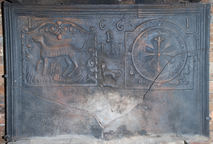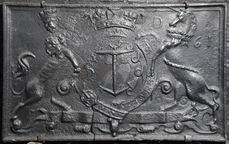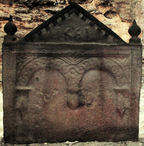-
13
Description: Rectangular; composite: complex (cavetto/cyma recta/ovolo) moulded edging (top and sides), derived from domestic carpentry; two firebacks used as patterns: on the left, rectangular with mirrored floriate scrolled top, simulated overlapping tile edging at sides, with fillet bottom edge, a mythical salamander in the form of a dog with an arrow-shaped tongue, standing among flames, a stapled scroll inside the left and right edges; on the right, arched rectangular with fillet edging indented on the inner side, surrounding a circular clock face with Roman numerals, each interspaced with a bead, and a button outside each quarter, a triangular design of swirled foliage in each bottom spandrel; initials in triad between firebacks; below, stamp formed of a talbot statant guardant upon a wreath; date split: ‘1’s in top corners, ‘6’s above initials; bottom third of fireback plain.
Notes: The talbot crest, which in this instance has been over pressed and shows the shape of the backing, is seen on other firebacks indicating a common source; the 'salamander' fireback (see no. 851) is one of the Stapled Scroll series; composite firebacks (where the impression of one or more other firebacks are used as part of the decoration) are uncommon in England but less so in France.
Inscription: 16 61 / IBM [triad]
- Decoration tags:
- rectangular (shape)
- complex, furniture-derived (edging)
- composite
- individual letters
- individual numbers
- heraldic
- mythological
- text
- animals
- objects
Manufactured: in 1661 in the Weald area of England.
Current location: in private hands, Ardingly, West Sussex, England.
- Attached to series:
- Composite firebacks
- Talbot crest series
-
220
Description: Rectangular with cavetto moulded edging; English Royal supporters (crowned lion and unicorn) standing upon a cartouche, upon which rests a blank motto scroll; above, an anchor, surrounded by a looped cable is encircled by the Garter ribbon, which is surmounted by a royal coronet; the numbers ‘61’, presumably part of the date, are to the right of the unicorn, and a letter, ‘D’, is placed between the unicorn and the coronet.
Notes: From another casting of the same back, the date is known to be 1661. The cabled anchor is the badge of the Lord High Admiral who, in 1661, was the Duke of York and Albany, later James II. The missing initial is an ‘I’, for Jacobus Dux. The absence of the motto may be explained by the pattern being a carved armorial panel where the motto text, unlike that of the Garter, was merely painted.
Copies of this fireback are known.
Inscription: [I] D / 16 61
Arms: Lord High Admiral of England
- Decoration tags:
- rectangular (shape)
- cavetto (edging)
- whole carved pattern
- individual letters
- individual numbers
- armorial
- text
Manufactured: in 1661 possibly in the Weald area of England.
Current location: Preston Manor, Brighton, East Sussex, England.
Museum number: PM400269 (part of the Brighton Museum museum group)
- Attached to series:
- Miscellaneous royal firebacks
-
925
Description: Rectangular panel with moulded edging (top and sides); two joined guilloche arches with bracket ends and floral designs in the spandrels; above, pediment with dentil edging, between teardrop pinnacles; date in bottom centre of pediment; possible initials below and between arches.
Notes: The pattern has been formed from, or in imitation of, the upper part of the back of a joined 'wainscot' chair with an inserted date and possible inserted initials
Inscription: 1661 / [?W] [?H]
- Decoration tags:
- rectangular with pediment (shape)
- complex, furniture-derived (edging)
- whole carved pattern
- individual numbers
- architectural
- text
Manufactured: in 1661 in England.
Current location: in private hands, Wigmore, Herefordshire, England.
- Attached to series:
- Chair pattern firebacks
- Furniture stamp firebacks


